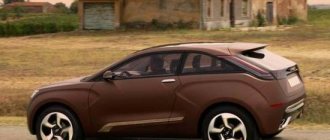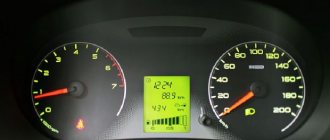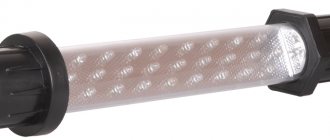Features of the transition of the 8-valve Lada Granta to LPG
Before switching from gasoline to gas, you need to know the main features of gas equipment. The quality of installation of the cylinder is very important, on which the service life of the gas equipment on the Lada Granta depends. Also, before making the transition, you need to decide on the equipment manufacturer.
There are equipment from different brands on the market, which differ in price and characteristics. Another stage is the choice of generation. The LPG must be suitable not only for the car itself, but also for the climatic conditions in which the car will be operated.
Many car owners, before installing gas equipment on Granta, wonder how safe it is. If the cylinder is installed correctly, the risk of gas leakage is completely eliminated. After all, modern equipment is equipped with both electronic and mechanical safety features.
As for the effect on the engine life, HBO even makes the engine work 1.5 times easier and the engine starts to run quieter and softer.
When switching to LPG, it is worth considering one more feature: during installation, questions arise about the fuel pump and injectors. However, experts give a clear answer: you need to turn off the injectors. There are two scenarios here:
- Use the program. Thanks to the necessary firmware, the system will have two modes - gasoline and gas. If the car is running on gas, the injectors will not turn on automatically.
- Organize correct fuel supply. This method is suitable for a transitional mode if, for example, the car did not initially have a gas system.
With high-quality installation and proper timely maintenance, the gas equipment will last a long time, and the car will cover more than 200,000 km.
Lada on methane
Why is it so expensive? The bulk of the cost is for cylinders. They are divided into four generations depending on the material and manufacturing technology. If relatively simple and cheap steel cylinders of the first generation are suitable for buses, then in passenger cars the cylinders should be as light as possible - and it is better to use plastic reinforced with carbon fiber. VAZ people think so, although the Volkswagen concern uses both composite and steel containers on different models.
On two fronts
Engineers tried modern cylinders only on Vesta. In fact, this is a prototype demonstrating what a gas-fueled car should ideally look like. The containers are hidden from view under the raised trunk floor in a redesigned niche where the spare tire is usually kept. The filling connector of the modern international standard ISO 14469-1 is located under the gas tank flap - after all, it’s not for nothing that the size of the latter offends the feelings of connoisseurs of beauty. But the main thing is that Vesta has a dual-fuel engine control controller, which ensures optimal operation on both one fuel and the other and an imperceptible transition from gasoline to gas and vice versa. The control unit was developed by the domestic company Itelma, which supplies the lion's share of electronics for Lada. Such a controller can be easily calibrated for a car with a robotic gearbox; it can be equipped with functions for simultaneous injection of gasoline and gas, which is required in certain modes.
We decide on the generation of gas equipment and the manufacturer
As mentioned above, you need to approach the choice of equipment manufacturer and LPG generation wisely. And, of course, decide on the gas - methane or propane.
Methane costs less, about 11 rubles per cubic meter, while propane costs 15-16 rubles. However, when installing methane gas equipment, you will pay more, since the cylinders themselves are quite expensive. In addition, methane is consumed faster. Next, we decide on the generation of gas equipment for the Lada Granta. Motorists usually choose between the 4th and 5th generations, since the previous ones are not economical or technologically advanced. Of course, with the fifth generation the car’s power will be stronger, but such equipment costs about 2 thousand euros, which is a bit expensive for a Lada Granta. Therefore, most Grant car owners stop at the 4th generation.
As for manufacturers, recently a new brand has appeared on the Russian market - Poletron. There are also well-known Digitronic and BRC. The equipment of the first two companies does not have additional gasoline injection. But as for the third brand, compared to its competitors, its original metal-ceramic rack has a service life of 220-250 thousand km, while most other manufacturers have 80-100 thousand. SEC EKO remains another well-known manufacturer. Thanks to the universal wiring harness and plastic housing, the equipment is inexpensive. However, this LPG will fit all injectors that are presented on the Russian market, and also has an ATS function.
Convenience and reliability of automatic transmission on Lada Granta
There is an opinion among experts that the Japanese classic 4-speed automatic transmission Jatco JF414E (AY-K3) is the most reliable and wear-resistant part of the Lada Granta. Motorists note that its service life is longer than that of all other components of this model. And indeed, this automatic transmission is time-tested: in addition to Lada and Datsun, this gearbox was installed on Nissan, Micra and Almera. Now mounted on Geely MK. Other automatic transmissions of this family were installed on Nissan Note, Daewoo Matiz, and Kia Picanto.
Pros and cons of switching to LPG on an 8-valve Lada Granta
Of course, car owners would not install gas cylinders on their cars if it did not have significant advantages. When installing HBO on
With 8 valves, you will, of course, save on fuel, approximately 50-60% with each refueling. In addition, switching from gasoline to gas has the following advantages:
- when using gas, the oil film formed by the lubricating fluid does not dissolve and is not washed off from the cylinder walls, thereby increasing the service life of the car engine.;
- the gas contains no harmful impurities of tar, sulfur and lead. Because of this, exhaust toxicity is reduced, the amount of harmful substances in the exhaust is reduced by 40%;
- thanks to HBO, there is no carbon deposits left on the car pistons, therefore, the lubricating oil remains clean longer;
- technical progress. The rapid spread of gas equipment began in Europe about 10 years ago. By 2020, Russia plans to switch from 10 to 50% of cars to gas.
IMPORTANT! The payback for installing a gas cylinder occurs in approximately 20,000 km, i.e. about 10 months of driving.
However, HBO on Grant also has its disadvantages:
- installation cost. Installing a cylinder will cost the car owner approximately $500 if the car has 4 cylinders, or $10,000 if the car has 8 cylinders. For a one-time payment, the sum is considerable, but it quickly pays off;
- space in the trunk. Of course, the cylinder is bulky and takes up a lot of space. Alternatively, place it in a special niche for the spare tire. In this case, the HBO is not visible, and the trunk is empty. And the spare wheel, if necessary, can simply be put in the trunk;
- loss of warranty. If the vehicle is still under warranty, the dealer will cancel the warranty when switching to gas.
But, despite the shortcomings, installing LPG on the Lada Granta is a profitable procedure.
The undeniable advantages of HBO
Installing LPG on the Lada Granta (liftback) is justified many times over.
Reduce waste
It is enough to estimate the cost of one kilometer. Compared to 92 grade gasoline, butane-propane is 2 times cheaper.
Knock resistance
Gas is characterized by a high octane number. And the higher this indicator, the less harm the fuel (gas) does to the connecting rod and piston group. Therefore, in a Lada Granta (liftback) car running on gas, the service life immediately increases by an average of 35 to 45%, and the mileage “from repair to repair” increases by 1.5-2 times.
Increase in operating resources
Gas allows you to increase the service life of the catalytic converter by 40%. Changing spark plugs is required less often, since gas combustion does not produce carbon deposits. Therefore, installing gas on the Lada Granta (liftback) will allow the owner to appear less often at service centers, as well as at service stations. The gas does not contain lead, which “kills” the lambda probe and the combustion chamber of the cylinder head.
Increasing the environmental friendliness of exhaust gases
The motor oil in the LPG engine does not liquefy. It will need to be changed quite rarely. Among other things, the Lada Granta (liftback) with gas equipment passes technical inspections more easily: the absence of harmful emissions increases the environmental friendliness of the vehicle's emissions.
Economical fuel consumption
The explosion hazard of a car running on gas is noticeably less. When transitioning from the initial liquefied state to the gaseous state, it cools to a temperature of – 130? Gas consumption on a Lada Granta (liftback) will be 10-15% higher than gasoline (according to reviews from already established owners of LPG).
Installation and Maintenance
If you think that you can install a gas cylinder yourself without experience and skills in this matter, then you are unlikely to succeed. To install the equipment, it is better to contact specialists. When working, you need to weld brackets and carry out wiring, which a non-professional cannot do efficiently, and safety depends on the quality of the installation. The 42-liter tank is installed in the spare wheel well. Then it can be covered with trim, and the trunk will look aesthetically pleasing again.
If the niche is too small for you or you need it for other purposes, then a cylinder (cylinder) with a volume of up to 80 liters can be installed directly in the trunk.
In the Lada's interior there is a button that switches the fuel type: from gas to gasoline and vice versa.
IMPORTANT! If the gas runs out, the car automatically switches to gasoline fuel.
You can also install a Euro multi-valve. With its help, the driver will be able, while in the cabin, to see how much gas fuel remains in the cylinder.
In order for the equipment to work for a long time and without interruptions, it must be serviced in a timely manner. This includes regular replacement of filters, purging of the editor and fuel line, and setting up the software.
Is it worth installing gas equipment (GBO) on Lada Granta cars?
So, how compatible is a machine from a domestic manufacturer with gas equipment, what are the advantages and disadvantages of this method, and can problems arise after installation? Today, the problem of saving on fuel is not new, and many people are increasingly thinking about installing gas equipment. Owners of a Lada Granta car, by definition, already saved money by purchasing such a model, but still the very idea of using natural liquefied gas as fuel is very tempting. If a person travels a lot, then he should definitely think about the fact that gas is much cheaper than gasoline or diesel fuel. Gas has already proven itself quite successfully in conjunction with a carburetor system, and now it is being transferred to injection systems. However, in the latter case some technical problems arise.
Gas is more dangerous than gasoline
This is somewhat true. Incorrect installation of gas equipment can cause a leak, which is more difficult to determine, and the gas ignites more readily than gasoline. In this case, liquefied gas, which is heavier than air, is especially dangerous - it does not rise up, but accumulates under the car, in pits and basements of garages.
The pressure gauge at the gas station shows that gas is being pumped into the cylinder under a pressure of as much as 16 bar. But when the shut-off valve is activated, 85% of the gas will remain in the liquid phase and 15% in the vapor phase. Therefore, the pressure inside the cylinder drops from 16 to 8 bar - and this is no longer such a frightening indicator. For example, truck wheels are inflated to comparable values.
Possible problems on different control units
For example, the first problem, which is also the simplest, sounds like this: “What to do with the fuel pump and injectors?” The answer is also simple - it is recommended to turn off the injectors. Here are some ways to do this: the first is the software method. Specialists use firmware for two modes - gas-gasoline, and when the LPG works in the Lada Granta, the injectors do not work. The second way is to turn off the injectors using a relay or an injector emulator. You can do the same with the gasoline pump to prevent it from running idle. Or you can leave the pump on and thanks to this the injector ramp will quickly cool down.
There are “January” firmwares (not yet installed on Granta, but in the future it is possible) - they can implement firmware with a dual-mode program. There are two parts of the program for working with gas equipment - as the name implies, gasoline and gas. Injector and fuel pump drivers with ignition correction for optimal functioning with gas are disabled. In the BOSCH M 1.5.4 control unit. There are also two modes, but if you use it for the Lada Granta, you won’t be able to turn off the injectors, because there is only one program, but there are two calibration sets. In this case, use direct shutdown and a simple injector emulator. Complex types of emulators contain field keys that are needed to obtain a disconnection without interruptions. There are options when the process of switching between firmware is done automatically. The gas valve turns on and, accordingly, the firmware for gas should turn on next. Moreover, with such a switch on the Lada Granta, a short circuit to the ground terminal from pin 52 of the ECU may occur.
In addition to what has been described, there is another problem - how to implement the correct gas supply. This is especially true for transitional modes, in which the combination of systems with gas-cylinder equipment is not initially envisaged. For example, we can mention a long coasting motion, and then when the throttle opens you can hear “pops” - this is how the lean mixture in the receiver explodes. When the car is coasting, a very rarefied atmosphere is created in the receiver, and when the damper is already open, a large amount of air is sucked in. HBO does not take such things into account, and explosions result. Because of them, it may happen that the mass air flow sensor fails. Three to five strong “claps” are enough. That’s why receivers have firecrackers at the input—this is done when installing HBO. True, the pops still remain, but there are fewer of them. The dynamics of the car may change for the worse. In the Lada Granta with gasoline, the passage hole at the receiver inlet becomes narrowed. The firecracker itself can also become deformed during explosions.
There are cases when popping noises also appear when using gasoline fuel - when the ignition is turned on. During the process, gas enters the receiver without interruption - that’s why popping noises can be heard constantly. When the ignition is turned on, there is a spark - this is how some injection systems turn out to be a glitch. To get rid of it, it is recommended to install a relay that will delay the supply of power to the ignition module. Some people also call it “anti-fluff”.
Now let's talk more about the third problem. It is connected to new electronic control units from Bosch - MP7.0 and M7.9.7. Such systems were developed for toxic standards according to Euro-2 and Euro-3 standards. The fuel supply calculation contains a mathematical model of the engine. The mathematical model will change all the time - it depends on the conditions of use and modes - this is called self-learning of the system. This is why it is impossible to switch to gas from gasoline at any time - in order for the Lada Granta to run on a different fuel, you need to programmatically reset the ECU - so to speak, clear what the system itself has learned. If the memory is not cleared, the machine will not work normally in either mode. That is why it is so difficult to install gas cylinder equipment on injection machines if they have BOSCH, MP 7.0. This block must be changed to “January” in any modification of the fifth version.
To solve the existing problem of passive gas supply to the receiver, a gas injection system was developed in Russia. They called it GIG-3. Patented gas nozzle included. In principle, the GIG system is a gas mono-injection, when gas is supplied thanks to a special nozzle based on a signal from its control unit. In theory, everything is quite simple and technical, however, an experiment was conducted in which out of three purchased kits, none of them began to work. The problem was the variable injector performance at random times.
Why do some people install HBO on the Lada Granta? Firstly, the most obvious thing is cheap fuel. Against the installation of gas equipment on the Lada - the cost of repairs after installation can cover the savings from the use of natural gas. Differences in engine operation when using gas and gasoline
The operation of an internal combustion engine on gas has technical features. The first is that gasoline, when sprayed, lowers the temperature of the valve. This does not happen when the car runs on gas. The substance propane-butane is characterized by the number of octane - 110 - because of this, combustion is slower and with a high temperature, which heats up the valves and seats. Basically, valves cool due to heat transfer during the contact of the valve plate with the seat. And all the gas burns without forming carbon residues. Gasoline contains a considerable content of oily hydrocarbon impurities, as well as additives that create a thin film on the surface with which the valve touches the seat and prevents rapid wear. If the system runs on gas, then during direct contact between metal surfaces, the temperature rises and the micromelting process begins with the oxidation of the melting products and the subsequent formation of an abrasive surface. And as a result, the surfaces wear out and heat transfer is disrupted. When the system is injection, it is necessary to adjust the ignition angle.
If you install HBO scrupulously, then, in principle, the universal installation method is fundamentally wrong. After all, gas, like other fuels, must be supplied in portions according to engine requests, and most receive a constant forced supply of gas. When a gas supply device is installed inside the throttle pipe, the passage opening of the air intake channel is reduced by two or more times. Then the Lada Grant will not have normal dynamics. The clapper, which is placed on the mass air distribution sensor, has a similar effect. Such things can be checked simply - you need to drive the car with the gas supply device removed. When operating in gas mode, the fuel injectors and fuel pump are forcibly cut off. In this case, incorrect data is entered into the control unit and, as a result, the machine operates in the wrong mode. Before installing LPG, it is worth checking the serviceability of the ignition system - namely the spark plugs, their tips and high-voltage wires. After the gas equipment has been installed, it is necessary to adjust the reducer and gas supply. There are special devices for this.
If you do not follow the recommendations, the result will be increased consumption of gasoline and gas, and starting the engine in cold weather will become increasingly difficult. And if the car runs on gas all the time, the fuel injectors will become coked, and working on gasoline will be very unpleasant.
Satisfied owner Grants: eliminating the “childhood” disease of the car
As Pavel notes, he is generally satisfied with the 3-year operation of the car, during which 90,000 thousand kilometers have already been traveled, but the initial stage of such a long operation was the elimination of the “childhood” disease of the car - using a file to remove all the tides on the generator holder - points of contact - with a file with engine block.
To carry out this, to some extent cosmetic repair, it was necessary to remove the generator itself. Also, on the occasion of dismantling the generator, the mounting groove was bored, as a result of which installation becomes easier, and the generator mount fits tightly to the engine. As a result of the manipulations carried out on the car, Pavel corrected the situation with the strong factory tension of the alternator belt.
As for the costs of repairs and replacement of components, as well as modernization of the car, the owner provides the following figures:
• replacing the DRL light bulb (3 times in three years of operation) = 300 rubles. (100 rubles – one replacement);
• changing the engine oil (Lukoy 5W-40 every 10,000 thousand km) = 1,250 rub./4l;
• oil in the box (Liqui Moly TOP TEC) = 950 rub.;
• installation (gas equipment) of 4th generation gas equipment = 19,000 rubles.
As for the installation of gas equipment, the solution turned out to be quite profitable, and in just a year the installation completely paid for itself. Moreover, the benefit lies in exceeding the savings threshold, namely saving 9,000 rubles that would have been spent on the A-92.
The owner expresses special gratitude to the designers of the Lada Granta, since the valves do not bend, and there are only positive aspects from using the car. The only thing is that when the mileage reached 82,000 thousand km, the timing belt broke.
As advice, the car owner says there is no need to rev the engine above 3,500 thousand revolutions, as well as the timely need to change the oil (every 10,000 thousand km).
Reviews from owners of Lada Granta standard with the opposite opinion: the need to carry out preventive measures in advance than specified in the service book
Another owner of a Lada Granta with an automatic transmission claims that the car has shortcomings related to the software part of the car (check engine). The occurrence of such an error is quite common.
In some cases, service stations claim that there is moisture in the electronic control system, and in some cases, they say that it is necessary to replace the assembly unit. In Valery’s case, based on his review, the check engine light forced him to visit the service station twice, and the first alarm was a false alarm.
As for the second time, when the check engine light made itself felt, the brake sensor was replaced at the service station.
The owner describes the car as a modern, dynamic, stable vehicle, although he complains about increased fuel consumption. On some road sections, consumption exceeded 16 l/100 km.
The owner notes the need to first replace the timing belt, since if it breaks, the valve bends. This testimony differs from the previous review regarding the quality of the car valves. Maybe it's all about the assembly? After all, this is a domestic car!
The service book indicates the need to replace the timing belt at a mileage of 74,500 - 75,500 thousand km. The owner, in turn, advises replacing it for another 50,000 thousand km, which will avoid deformation of the valves.
Lada Granta standard owner reviews: innovation from the owner (molybdenum sulfide as a guarantee of comfortable operation of the manual transmission)
The owner himself, Ilya, put forward for consideration by other owners a certain precedent regarding improving the operation of the manual transmission. The essence of this proposal is to add molybdenum sulfide to motor oil. It is recommended to change the oil, taking into account molybdenum sulfide, immediately after running the car - 2,000 thousand km.
Ilya claims that such a unique additive in gearbox oil prevents the formation of noise and whistling when changing gears.
Everything about HBO on my Lada Granta. Methane or propane?
Lada Granta 2016
- Hello again!
Today I decided to add to my review of HBO. I think this topic will be of interest to those who are still thinking: whether to bet or not. And at the same time I’ll tell you about the difference between LPG equipment using methane and propane. So, let's begin. Personally, I (and, in fact, everyone else) installed gas in order to save money, as you know, gasoline is becoming more expensive, but gas, no matter how you look at it, is still cheaper.
This is the 6th car I have (since 2003) that has been supplied with gas, so I know almost everything about operation on this type (or I think I know almost everything) as a consumer.
I installed 4th generation HBO (Italy) in my grant. The installation cost me 27,000 rubles (including work) and took 6 hours. Because I am a law-abiding citizen, so at the same time I submitted documents for registration with the traffic police, and this is another 2000 rubles. (in Togliatti) this does not include a duty of 800 rubles. An equipment installer company (MAKS-GAZ) helped me register.
So, what's included in the package:
— a 42-liter toroidal cylinder (with all valves and sensors) in the spare wheel niche;
— gas solenoid valve;
- gas ECU (or in common people - brains);
— gas-gasoline switch button;
View under the hood
I installed the switch button like this, for me this is the best option
I asked to put the filling neck in the bumper (this installation is paid and costs 300 rubles, if you put the filling neck in the gas tank flap, it will cost an additional 1000 rubles. Free installation (standard) - under the bumper).
Well, the cylinder itself was installed as I said above, installed instead of a spare wheel
The disadvantage of this installation is obvious - you will have to carry the spare tire in the trunk (or abandon it altogether). There is, of course, an alternative, but it is doubtful, because... with her in my case there will be even more inconvenience
After installing the gas system, I went straight to reflashing the standard “brains” of the car, where they corrected the operation on gas, plus I reflashed the car for Euro-2 - another 2 thousand rubles. (in principle, you don’t have to do this).
Consumption on gas is 10 liters (1 liter more than on gasoline) per 100 km (city-highway 50 to 50), i.e. a 40-liter cylinder is enough for me for 400 km. Today I fill up gas for 20 rubles. per liter, which means a full cylinder costs me 800 rubles. One refill lasts me 5-6 days of driving.
In addition, once a month I fill up 10-15 liters of gasoline, because... The car always starts on gasoline, after it warms up to 50-60 degrees, it automatically switches to gas. When the gas runs out, the switch button starts beeping and the car automatically switches to gasoline.
For servicing the gas equipment, this procedure must be done every 15 thousand km; this event costs between 1000-1500 rubles (depending on what was done and changed).
Now I want to compare equipment running on methane and propane, indicating the positive and negative aspects.
— savings on fuel (approximately 30-40% compared to gasoline);
— a large number of gas stations;
— mileage on one gas station is almost the same as on gasoline;
— it is possible to select the type of cylinder (toroidal or cylindrical);
— relatively low installation price;
— ease of operation;
— the life of the motor increases by about 50%, provided it is properly configured;
— absence of engine detonation (since the octane number of gas is 102-104 units);
- not expensive service.
— takes up space in the trunk;
— power loss 4-10%;
— the price of gas (unlike gasoline, it has large fluctuations, so this year in Togliatti the price ranged from 15 rubles 90 kopecks to 20 rubles 50 kopecks, in other regions the price could change even more);
— savings on fuel (approximately 50% compared to gasoline);
— methane is cheaper than propane (today in our city the cost of 1 cubic meter of butane is 15 rubles);
— there are very few gas stations (for example, there are 5 of them in the entire Samara region (in Tolyatti-1);
— mileage on one gas station is extremely low (about 290-350 km), which greatly complicates the use of this equipment on highways during long trips;
- the equipment costs much more - 60-70 tr. for installation;
— the weight of an empty cylinder is about 70 kg (which is a lot, in my opinion);
— there is no alternative to choosing a cylinder - only cylindrical
and from here all his shortcomings;
— there are few specialists in its setup and maintenance.
That's probably all. It's up to you to decide what equipment to install.
Conclusion: HBO can be installed if the car has high mileage per year, but if the mileage per year is 5-10 thousand, then you can drive on gasoline.
Reviews of Lada Granta
Guest
wrote: April 20, 2012 at 04:36 pm
Hi all! I'll add my 5 cents. Mileage on Grant (Norma) 3,000 km.
I. The first impression after the purchase is the understanding that VAZ is deceiving us, namely, with its statements about increasing quality control. Why ? Firstly, while driving home from the salon I was tormented by a knock in the rear right door. At home I found out that the rods were not in their seats. Was it difficult to check or are all deaf people working there? Secondly, I barely made it home, because... The car jerked, stumbled, and did not move at all at low speeds. Later, the device showed that all the G..NO candles were three this way and that, and one was completely zero. And where is the control here?
II. Now about comfort. After 21099 and Spectra, the landing seems higher. In principle, it is as comfortable here as in Kalina, and very spacious. The rear seat, unfortunately, is not a seat, but a piece of foam rubber molded onto the bars (without a body). Low quality fabric wears out very quickly, so it’s better to buy covers without delay, even the cheapest ones will be better.
There are no limit switches in the passenger doors, keep this in mind when installing the alarm. There is no upholstery for the threshold either, but I don’t need it. I really liked the mirrors, excellent visibility, easy to park. The trunk is huge - larger than in the Priora. The light is excellent, better than in the Spectrum. I am also pleased with the presence of DRLs, I would not say that they are very bright, quite normal. The stove is also a bomb and also better than in the Spectrum.
A few words about audio preparation: wires were installed to the speakers in the rear doors, but the conditions for installing the speakers were not provided. There are no holes for them, no normal area on the upholstery. What do they propose to sculpt in the center of the plastic or something? In general, about convenience, that’s probably all. In principle, I’m happy with it, if anyone is missing something, wait for the “Lux” version.
III. dynamics. I will compare it with the tuning version 21099, Kia Spectra, Kalina 1.4 and Priora. I really liked the torque of the engine. Without a doubt, in the entire range it is better than the Kalinovsky 1.4, at the bottom it is more nimble than the Priorovsky, however, at high speeds the latter is a little more cheerful. As for 21099, in general, its modified engine only responds more poorly to the gas pedal, unlike 21116, and it is easier to slip into gear, up to 3rd gear, but then, of course, it gets worse and overall the Granta pulls better. And here's the engine. I liked the Spectra better - it pulls well both at the bottom (it quickly picks up speed in 4th gear from 40 km/h, and starting from 2nd gear is like nothing!) and at the top up to 5,000 rpm. Even at a speed of 190 km/h, she feels the gas and goes further, which, I think, is impossible on the Grant.
IV. Controllability has the advantage of a lower number of steering wheel revolutions. On the downside, the car is really bad at cornering and doesn’t hold the road very well at speeds of 120 km/h or more. But this point can be easily corrected, change the old tires, which have been lying in warehouses for 10 years, to 185 or 195. And, if not critical, reduce the ground clearance. It was also unusual for me to drive with an electric power steering system; as I understood, it turns off at a certain speed. The power steering in the Spectrum always works; you can enter a sharp turn close to 90 degrees at a speed of 80 km/h by controlling it with two fingers.
V. The result is a great car, and I like it, especially for the money. Yes, something may have to be completed, modified, but this is not a problem. If you are choosing between Granta, 2115, Kalina, Priora, Nexia and Zaz Chance, then I would definitely advise choosing Granta.
Answer
I installed HBO on grant. Let's start the test
In general, my attitude towards gas in a car has undergone diametrical changes several times depending on a number of purely subjective factors (hey, I brought out the “goose”). To put it simply, I have encountered both negative and positive on different machines, but I would not draw any general patterns. It all depends on the situation.
My first acquaintance with gas equipment took place ten years ago; it was installed in one of my Fords and its condition was far from ideal. Naturally, my knowledge of HBO was at the level of OBS - one grandmother said. But since it was very tempting to save on fuel, a craftsman was found at a garage cooperative who revived the installation, and for some time I began to drive on gas. It is clear that the HBO itself was primitive, first generation, installed rather crookedly and, naturally, I did not get much pleasure. A number of inconveniences negated all the positive benefits of the opportunity to save money. When switching to gas, the Ford Taurus began to feel noticeably dull, this was especially noticeable on climbs, when the detonation was sometimes so audible that it seemed like the engine was about to jump out. In addition, it would not start on gas, this is understandable, but, in addition, if you turn off the engine without first switching to gasoline, then it will be difficult to start on gasoline. Not to mention the fact that all switching was done manually through a toggle switch barbarically embedded in the dashboard, at least not in the most noticeable place. In general, all this left its mark on my perception of LPG, and after switching to another Ford, I didn’t even try to install gas.
This topic came up again a few years later, when a working gazelle was purchased with a 405 injection engine, which had gas equipment. I can’t say that there were many problems with this car, except that it was impossible to achieve stable operation at idle. The revolutions would jump up to two thousand, then drop to less than 500, and the gazelle could stall in the most inappropriate places, for example, near the ticket office at the toll booth, tightly blocking the passage. Moreover, the same trend was observed - if it stalled on gas, then even on gasoline it was very difficult to start. Nothing helped - neither replacing the idle air valve, nor replacing the throttle valve and a bunch of other sensors, nor repeated washing of everything possible. So they sold it with this problem.











